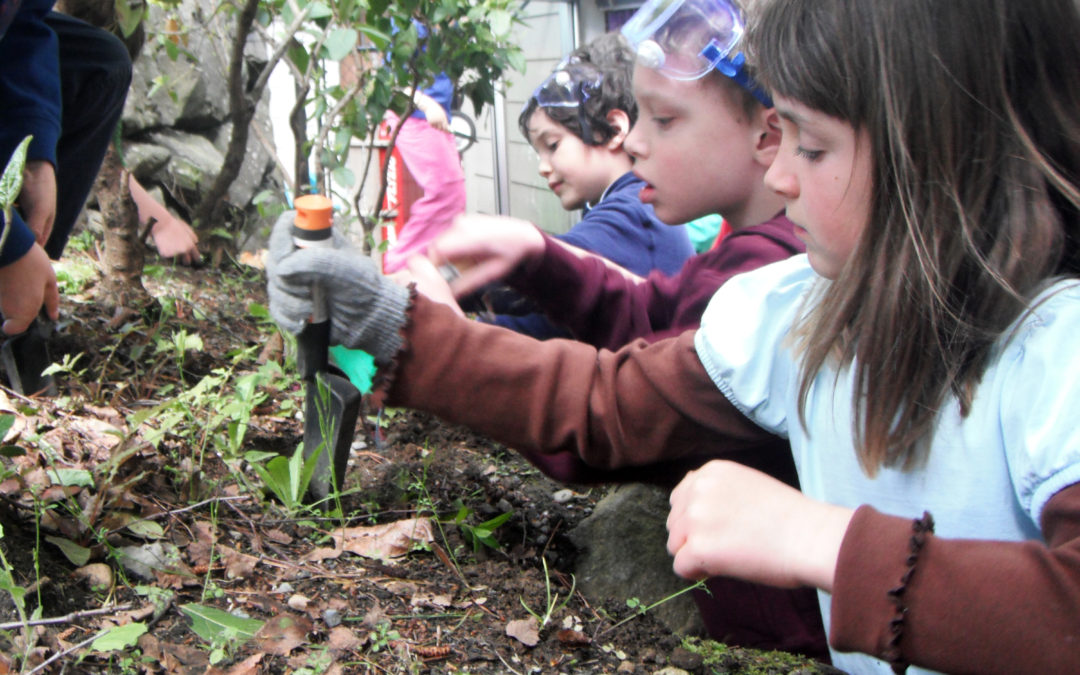Five years ago, I was tasked with developing what came to be called U.S. Department of Education Green Ribbon Schools (ED-GRS). You may have heard of it. The recognition award is now known for honoring sustainable schools annually.
What is a “green” or “sustainable” school, you ask? Well, we established a federal definition when we created the award. That federal education definition includes three broad areas that we call Pillars. Pillar I is ‘Reducing Environmental Impact and Costs‘, including waste, water, greenhouse gases, energy, and transportation. Pillar II is ‘Improving Health and Wellness‘, including physical activity, nutrition, and environmental health. Pillar III is ‘Teaching Effective Environmental and Sustainability Education.’
State education authorities voluntarily nominate up to five schools and school districts and up to one postsecondary institution each year to the U.S. Department of Education (ED). We announce the honorees on or near Earth Day and then invite them all to a special ceremony in Washington D.C. in the summer.

Garden work at Detroit Edison Public Service Academy in Detroit, MI, a 2012 honoree
That’s the part that most people know. What I’d like to discuss are the common misconceptions about ED-GRS:
- The Obama Administration developed this because they are environmentalists. Regardless of personal opinions, conservation is not ED’s mission. In fact, credit for this initiative belongs to the field. It was proposed to us by 80 national organizations – from the principals to school boards to the health organizations and school facilities advocates. They requested, in a joint letter organized by long-time environmental buy ambien in canada education advocate James Elder, that ED develop a recognition award at the intersection of school facilities, health, and environment.
- Only new school buildings can qualify. The award is structured such that schools, whether they are old or new, rural or urban, small or large, can qualify under the criteria. We ask state education authorities to send ED their highest-performing nominees across the Pillars. We don’t pit states or nominees against one another, nor do we compare different types of schools. We look to see that they are progressing in each area. ED has honored 1917 schools that are doing great conservation work. One of the things I try to ensure as Director is that we review nominees in their context. Interestingly, many of the best honorees serve a majority disadvantaged student body. I guess it shouldn’t surprise us that under-resourced schools know how to get, well, resourceful!
- It’s just a K-12 school award. While we began with just a school award in 2012, we added a District Sustainability Award in 2013; a Director’s Award (to honor a state official advancing sustainable schools practices) in 2014; and a Postsecondary Sustainability Award to honor institutions of higher education in 2015. Though the bulk of the nominations are for schools, we now have selectees from every category each year.
- Green schools are primarily about energy efficiency. A green school, as we’ve defined it, means all three Pillars, not just one. We’ve turned away highly efficient, green building standard-rated schools when they were not demonstrating a commitment to other Pillars, such as sustainability education. Along the same vein, not all green schools feature renewable energy. That is an add-on, but never a requirement. Most schools are doing less glamorous but fast payback retrofits and educating their community on conservation behaviors. As one of my architect colleagues has put it, these schools “eat their conservation vegetables before getting renewable energy dessert.”
- Pillar III is STEM or STEAM. Our Pillar III is for nominees to show that they are teaching effective environmental and sustainability education – that is, hands-on, project-based, authentic learning about how humans relate in dynamic, interdependent environmental, economic, and social systems. The best sustainability education we’ve seen is integrated through all subjects, including arts, languages, and social studies. It offers opportunities to exercise higher order thinking skills, problem solving, and collaboration, all in a real-world context. While it is popular to speak of STEM programs, robotics, and maker spaces; to educate effective citizens of the future; and to receive this award, it is not enough to have a robust STEM program. Schools must ground themselves in environmental education and education for sustainability.
- You have to spend a lot of money to become a green school. Through their conservation behaviors, efficiency upgrades, waste reduction and, yes, a few renewable energy features, honorees are saving millions of dollars annually, and putting that money into more staff positions, more school garden materials, and engaging, hands-on field trips, among many other possibilities. Precisely because school budgets are tight, administrators must be concerned with resource efficiency. It costs more to run those faucets, haul that trash, and heat those empty classrooms.
- ED-GRS requires a very long, complicated application. States are asked to show ED how their nominees are progressing in all three Pillars. How each state does that is entirely up to the individual state. There is no required federal application. In fact, I’ve often said that states can have nominees write a single narrative per Pillar. If a state has a very cumbersome application process, I’ve encouraged it to simplify. There is no federal requirement that the application be lengthy.
- ED is now certifying green schools. ED-GRS is not a certification program or a rating system. We use the award to communicate resources that all schools, districts, and postsecondary institutions can use. For this reason, any given institution can only receive the award once and we seek to honor just a small cohort each year. We don’t need hundreds of examples of innovative practices each year to communicate them. A few serves us just fine to communicate good work, and keep the administration of the award trim.
- Honoring so few schools, districts, and IHEs can’t have a broader impact. The aim of the award is to use a small number of honorees each year to communicate practices and resources that all schools can employ, so our work is all about amplification. To this end, we launched Green Strides, an effort to connect all schools with the resources these honorees are using in the three ‘Pillars’ of our award. We publish annual Highlights Reports detailing the honorees’ replicable practices. We’re on Twitter and Facebook , publish a blog, and distribute a newsletter that allows to share resources and practices in the areas of school facilities, health, and environment. To bring further attention to the honorees and their practices, we conduct an annual Green Strides Tour.
- If my state has never nominated for this award, there’s no hope of my school, district, or IHE being selected. Every year, schools, districts, and postsecondary institutions have successfully contacted and informed their state education authorities about the opportunity to nominate for this award. If your state does not already nominate, you can contact your Chief State School Officer or State Higher Education Executive Officer and request that they participate. Many of the states that already participate have designated contacts listed here.
- Green by any other name will smell as sweet. Our name is pretty important, since there is another entity with a very similar name. ED’s award is called “U.S. Department of Education Green Ribbon Schools.” It has “District Sustainability Award” and “Postsecondary Sustainability Award” categories, in addition to the original school award. It is abbreviated ED-GRS. “Green Ribbon Schools” without the “U.S. Department of Education” is not ED’s award, but instead is a separate program overseen by another organization.
Now that you have a better understanding of ED-GRS, I hope you’ll use this as the tool it was intended to be – a megaphone for green school resources from federal and non-profit entities, a platform for innovative sustainable schools practices that save money while improving health and learning, and a producer of healthy, safe, sustainable school champions that can act as evangelists among their peers.
Still, we look forward to the day when all schools, districts, and postsecondary institutions are green and we can retire ED-GRS. Until then, I’ll continue to offer news of and reflections on green schools from the national perspective.
 Andrea Suarez Falken is Director of U.S. Department of Education Green Ribbon Schools and Facilities, Health, and Environment Liaison at the U.S. Department of Education. In her spare time, she explores Colorado’s natural wonders with her toddler on her back.
Andrea Suarez Falken is Director of U.S. Department of Education Green Ribbon Schools and Facilities, Health, and Environment Liaison at the U.S. Department of Education. In her spare time, she explores Colorado’s natural wonders with her toddler on her back.

